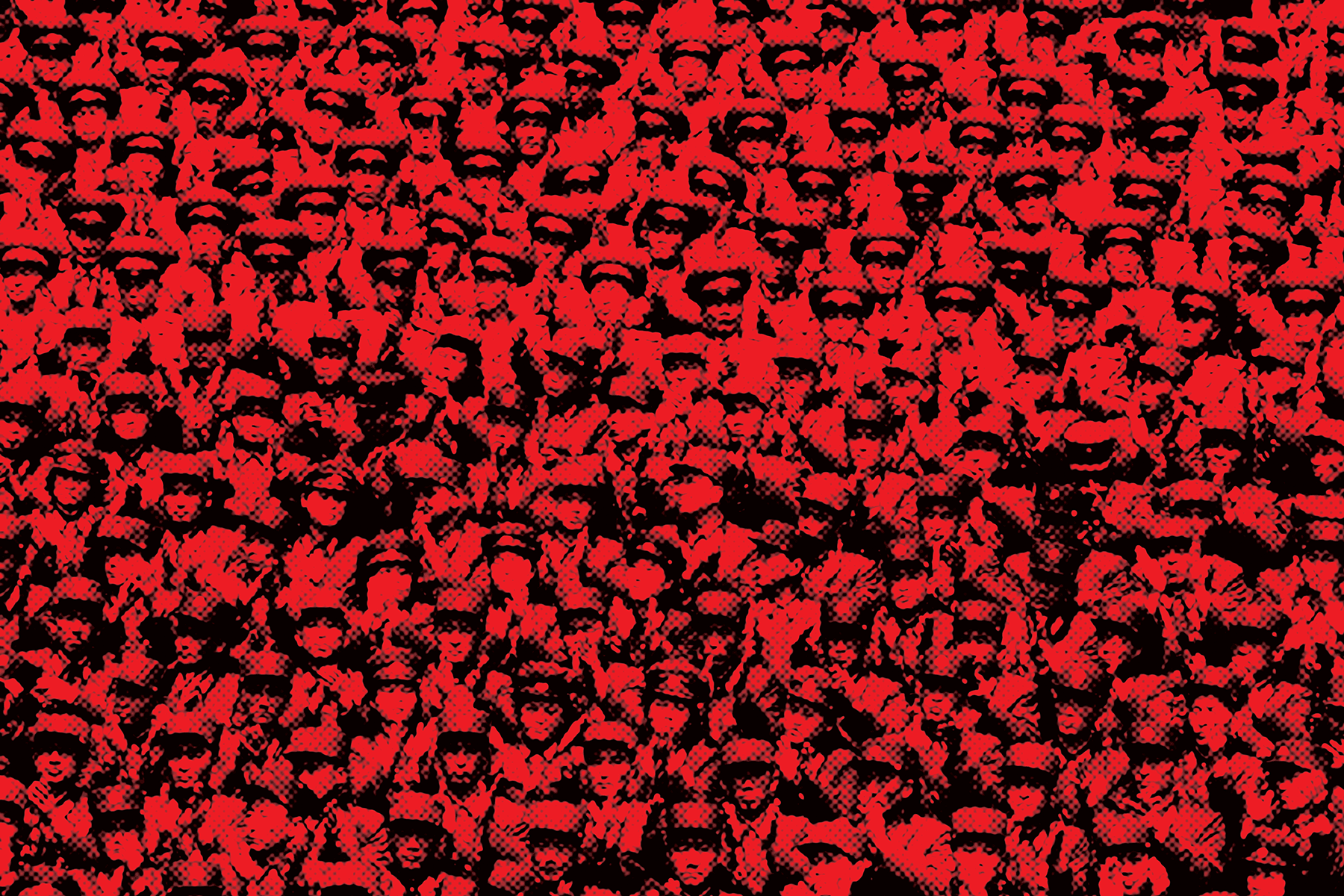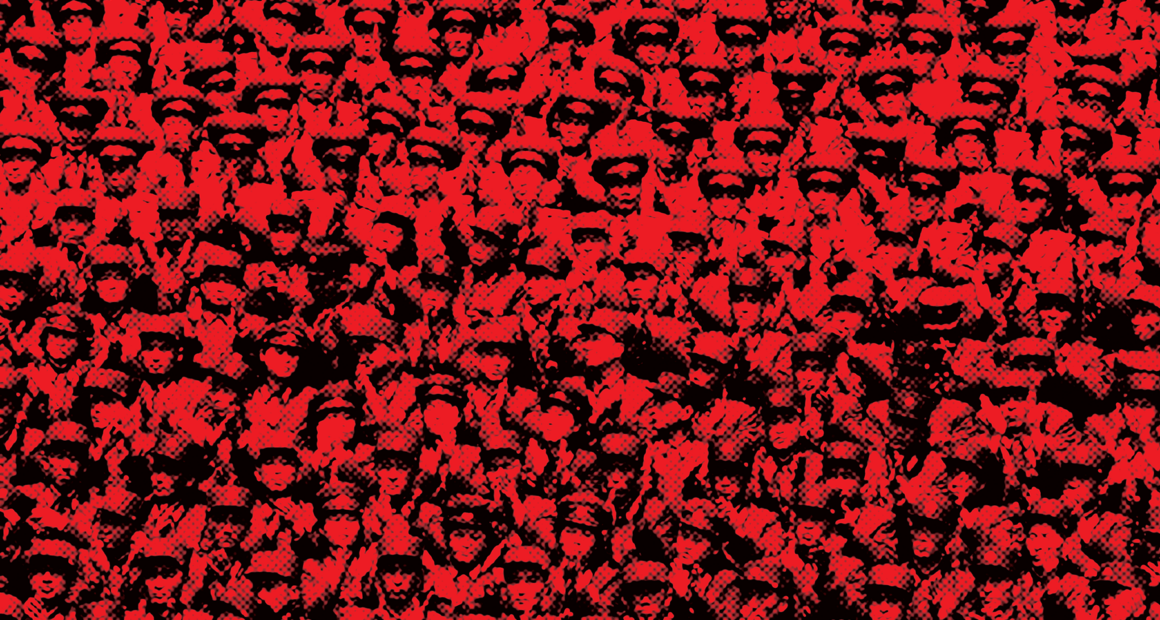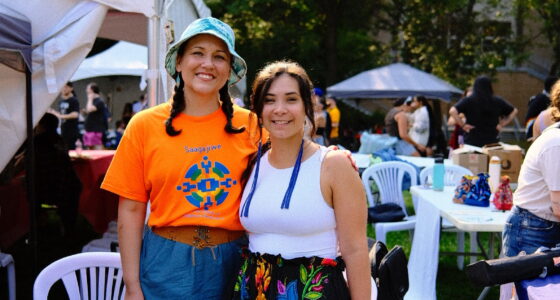News coverage of the “Hermit Kingdom” is sensationalist and reductive. Is Kim Jong Un more important than the country’s 25 million citizens?

Triumphant music swells as Kim Jong Un enters the room. Middle-aged men wearing dark suits and military uniforms stand in front of their plush red seats, already clapping in anticipation of the arrival of their leader, who cuts a striking figure with his white clothes among the blacks, greens, and greys. The live orchestra seated at the front of the room continues to play before a red backdrop depicting the symbol of the Workers’ Party of Korea—a hammer, a sickle, and a brush—that represents the worker, the farmer, and the intellectual, respectively. Uproarious, canned cheering loops as the camera pans the faces of the room’s occupants, a sea of gaping mouths and blurred hands. While the camera never stays in one location for more than a few seconds, an eerie sense of synchronicity among subjects evokes the feeling that they’re one unified mass, wholly devoted to celebrating the existence of their leader. All of this action plays out in a 40-second video titled “Noticeably Slimmer Kim Jong Un Appears in Public.”
The clip was used alongside an Associated Press article published in 2021 on the CTV News website. Headlined “State TV: North Koreans Heartbroken over Kim Jong Un’s ‘Emaciated Looks,’” the story describes his height (170 cm, or five feet eight), his previous weight (140 kilograms, or about 310 pounds), and his new weight, with some “North Korea watchers” theorizing that he may have lost anywhere from 10 to 20 kilograms, based on new footage of him.
This TMZesque focus on Kim Jong Un’s physique is nothing new for Canadian media. The Globe and Mail published an article mentioning how doctors who saw footage noted his “waddling gait and his shortness of breath” during high-profile diplomatic meetings in 2018. A 2014 National Post article sported the headline “North Korea Silly Season: Kim’s Feet Crushed Under His Own Weight Just Latest Rumour out of Secretive Dictatorship,” reporting on Kim Jong Un’s suspected surgery after his weight allegedly fractured his ankles. And in 2021, Vice remarked that the dictator had been putting on weight ever since he rose to power in 2011. Search “Kim Jong Un weight loss” on Google and hundreds of articles from both Canadian and international news outlets turn up, often relying on questionable sources such as anonymous North Korea experts or South Korean spies.
Over the years, news about North Korea has become synonymous with sensationalism. The coverage often revolves around a few predictable topics. If it’s not missile tests, it’s nuclear weapons. If not nuclear weapons, it’s some quirky development about the eccentric (and, as we are constantly reminded, overweight) dictator, Kim Jong Un. And if it’s not about Kim Jong Un, then you’d be hard-pressed to hear about it at all.
These reports often make up the whole of a typical person’s interaction—Canadians included—with notoriously insular North Korea. Seldom do people from the outside cross its borders to see the land and people for themselves. Coupled with the fact that North Korean citizens have even fewer ways to contact the outside world than those in China, Iran, or Russia—all of which have stringent restrictions on internet content and are known to censor media for the state’s benefit—and you have a fascinating, if tragic, case study of how public perception gets shaped for a group of people who have no way of defending or speaking for themselves.
At best, North Koreans are portrayed as hapless victims. At worst, they are a mindless mass who treat their dictator’s words as gospel. Most often, though, their existence is barely acknowledged as the world struggles to keep up with endless newsfeeds. There is no room to think about the real lives and plights of more than 25 million North Koreans when news organizations all over the world focus almost exclusively on their outlandish dictator.
No matter how important a security issue Kim Jong Un’s health is, obsessing over the particulars of his weight only leads to speculation better fit for gossip rags than serious reportage. Many foreign correspondents of large newsrooms in the West don’t speak the language of the country, or countries, they report on. Saša Petricic, a former CBC Asia correspondent, is one example, but for good reason—he was CBC’s only English-language journalist on the continent and had to report on over half a dozen countries at once.
There are workarounds, of course. Many of these reporters employ the help of translators on the ground and reference English editions of news outlets, if available (like The Chosun Ilbo, one of South Korea’s leading newspapers). This practice, however, can result in irresponsible overreliance on South Korean sources when reporting on North Korean state media. The latter is rightly treated with suspicion, but journalists often turn around and blindly report what South Korean reporters, experts, or authorities say with little to no scrutiny. This has led to multiple instances of major reporting errors.
Take, for example, an incident in August 2013, when The Atlantic, The Telegraph, and USA Today all reported that The Chosun Ilbo was running a story about the execution of Hyon Song Wol, the rumoured ex-lover of Kim Jong Un, for selling pornographic videos. The Chosun Ilbo article quoted an anonymous source as saying that Hyon was “executed with machine guns” alongside members of the Unhasu Orchestra and Wangjaesan Light Music Band, while “the families of the victims looked on.”
Journalist Sara C. Nelson also wrote an August 2013 article on this topic for The Huffington Post UK, consulting a North Korea affairs expert named Toshimitsu Shigemura, who was quoted by multiple outlets on this story. “If these people had only made pornographic videos, then it is simply not believable that their punishment was execution,” he had said in a Telegraph article, also dated August 2013—to which The Huffington Post links, except at some point the linked article removed any mention of Shigemura, with no indication that the piece had been edited. “They could have been made to disappear into the prison system there instead,” said Shigemura in the Telegraph article. “There is a political reason behind this….Or, as Kim’s wife once belonged to the same group, it is possible that these executions are more about Kim’s wife.” To everyone’s surprise, Hyon Song Wol ended up appearing on state media nine months after her rumoured death. She even visited the site of the 2018 Winter Olympics in Pyeongchang, South Korea.
Similarly, when Kim Jong Un missed the yearly celebration of his grandfather and North Korea founder Kim Il Sung’s birthday on April 15, 2020, speculation arose as to why that was the case. Daily NK, a South Korean newspaper that reports primarily on North Korea, published an article on April 20 saying that the dictator had undergone heart surgery on April 12. It cited multiple sources claiming to have insight into his condition. On the same day, MSNBC news anchor Katy Tur added fuel to the fire by tweeting that Kim Jong Un was “brain dead, according to two U.S. officials,” only to delete the tweet later. Speculation and rumours of his death ran rampant for three weeks until May 2, when North Korean state media released photos of him looking perfectly healthy.
Proximity is always a boon when reporting on a country, and generally results in more credible stories, but publishing word-of-mouth passed along by other news publications with little to no verification is an inexcusable practice, even when the topic in question is as closed off and secretive as North Korea. Not only does it lead to (and give leeway to) journalists writing articles using speculative language, but it also stops them from doing their due diligence and holding the North Korean government properly accountable for its actions.
This topic is something that South Korea country director Sokeel Park, of California-based nonprofit Liberty in North Korea, has spoken about. Park says this tendency is born from a journalist’s assumption that no straight answer will be given even if they ask, so they wait for public statements that they can dissect at their leisure. “They should be applying the same standards they would to other countries,” he says, “and demand answers from the government.”
At best, North Koreans are portrayed as hapless victims. At worst, they’re a mindless mass in Kim Jong Un’s thrall
News articles written about the North Korean military or government rarely contain even one line that indicates that the reporter or outlet reached out to either for comment. Take, for example, the failed missile launched from Pyongyang International Airport that scattered debris over the city in March 2022. Major news organizations were quick to deliver the news, as they usually are when it comes to North Korea’s munitions tests. They talked about the missile’s specifications and possible reasons for its testing. They talked about the reactions from other countries and the potential international ramifications of the explosion.
Only in passing did the reporting mention the damage to both property and people that an exploding missile could cause in a highly populated area. “If that rocket had been launched from JFK Airport and exploded over New York City,” Park said, “then the focus would not be just on the missile development program. It would be on what happened—were people killed, were houses destroyed, did it land on offices? But it’s so easy for journalists to just forget that North Korea is a real place.”
More of Anthony Kuhn’s 2022 story, “North Korean Missile Test Ends in Failure, as South and U.S. Watch for ICBM Test,” on NPR was dedicated to speculation and consulting experts on the timing of current and future missile tests, including such “insightful” observations as researcher Park Hyeong Jung’s comment: “North Korea’s missile tests will probably proceed in periodic cycles of compression and relaxation.”
Part of the problem is that it is so difficult to hear from North Koreans themselves, even those who have left their homeland. So effective is Kim Jong Un’s totalitarian regime that the people who have experienced and lived in it are still wary of its reach, even once they are beyond the country’s borders. In a 2017 interview with Global News, Kim Tae Gun, a refugee who settled in Canada, posits that the airing of his face on international news back when he first arrived in South Korea led to the torture and death of his parents.
If mainstream news media continue to report on North Korea and Kim Jong Un with such wild abandon, then the most vulnerable will continue to go unheard. Not only could irresponsible coverage lead to repercussions for those still in North Korea, but it also leads to important stories about North Koreans in Canada slipping through the cracks.
As early as 2017, Immigration, Refugees and Citizenship Canada (IRCC) had discovered that a subsection of North Korean refugees who sought asylum in Canada had hidden the fact that they also had South Korean citizenship. Since South Korea was deemed a safe country, and because South Korea automatically grants citizenship to North Korean defectors, their claim for asylum was invalid in Canada, leading them to face deportation to South Korea, barring unique circumstances.
According to an October 2022 article published in Radio Free Asia, headlined “Canada Deports More than 200 North Korean Escapees Who Took South Korean Citizenship,” many of these North Korean refugees first escaped to South Korea. It was only after landing there that they realized just how severely South Korean society discriminated against them. That’s one of the major reasons they left for their next destination: Canada. Migration is a highly stressful process that can take anywhere from several months to a few years. It’s no wonder that some of these asylum seekers lied about their status to gain an edge. “When North Koreans defect, they must break the laws in their country to do so,” says Kim Rok Bong, president of the Canada Federation of North Korean Defectors. Lying to the IRCC could seem to them as just another broken law atop the pile. What’s more, owing to their mostly isolated lives, they usually have little to no idea as to what breaking said laws could entail. They want a chance to settle down and to not be uprooted from the lives they’ve cultivated over the years in their new home. Despite this, 242 North Koreans had already been deported from Canada and 512 more were in the process of being sent back at the time of the Radio Free Asia story.
This issue initially received substantial coverage, as North Korea was high on news agendas in 2017, when the IRCC made its discovery about the refugees. According to Park, former U.S. President Donald Trump’s contentious relationship with Kim Jong Un at that time likely played a role in why the country was more frequently pushed into the limelight. CBC, Global News, the Toronto Star, even the Toronto Sun reported on the mass North Korean deportation crisis in Canada. Kim Rok Bong himself was interviewed for the Sun and Star stories.
Not all mainstream news topics on North Korea slant toward the negative. CityNews published an article in July last year about HanVoice, a Canadian human rights organization that helps resettle North Korean refugees, and its downtown Toronto exhibit, The People’s Museum of North Korea. The interactive art space showcased what the inside of a North Korean living room looks like. The exhibit raised nearly $20,000 for refugees and received more than 3,500 visitors, according to the HanVoice website. News publications such as The Washington Post, CNN, BBC, and more did stories about The Jangmadang Generation, a documentary featuring young North Korean refugees living in South Korea, all successful entrepreneurs first north and now south of the 38th parallel.
Occasionally, small steps like these are taken to rectify the damage done to the reputation of the North Korean people. Overall, however, Canadian media may prove unable—or unwilling—to do so.
Reporting on North Korea and Kim Jong Un with such wild abandon means the most vulnerable will stay unheard
The 2021 Canadian census puts the number of Canadians born in North Korea at 775—likely a low figure. Stories about the challenges that North Korean refugees’ experience are much less relevant to the average Canadian audience than ones involving the oddities of the entire “Hermit Kingdom”—that is, the missiles, the nuclear bombs, the palace intrigue, and more. Canada itself has very few North Korean refugees, says Kim Rok Bong. “We lack the power to make our circumstances a notable issue.”
Still, journalists have to do their jobs. Saša Petricic was responsible for covering news for the CBC in both East and Southeast Asia, including North Korea, South Korea, China, Hong Kong, Taiwan, Japan, the Philippines, and Indonesia. Based in Beijing, he had to keep a finger on the pulse of the news of all these countries. “The resources issue is one that always comes up,” says Petricic. “I’m one person, and we had a separate correspondent for the French side of CBC. So, that was two people. In terms of Canadian media while I was there, the Globe had a correspondent. That was pretty much it.”
Major Canadian news stations must funnel most of their resources into reporting Canadian news. Unfortunately, that doesn’t leave much space for international news in the country’s cultural sphere. Toronto journalist Steven Zhou’s analysis of foreign correspondents in Canada, published by Canadaland in July 2021, indicated that six major Canadian news organizations had a total of only 32 foreign correspondents. Seven of those 32 were journalists of colour. Most of those foreign correspondents were situated in the U.S. and the U.K. The few who weren’t were sent to far-off locations to cover multiple countries or regions at once. “You cover the things that are most important,” says Petricic, meaning the big stories and the ones “most relevant to your country and to your viewership. North Korea, frankly, is an interesting place. For some people, it is a curiosity. But it is hardly something that will affect most Canadians, arguably, in their whole lifetime.”
Sokeel Park argues that journalists could “socialize” North Korea into giving answers by firmly demonstrating that they have the same expectations of the country as any other nation. If Kim Jong Un and his government officials don’t respond, journalists should then try to contact them through the various North Korean embassies around the world. If the journalist also can’t reach or speak with people on the ground, Park suggests trying to approach those who were recently in the area to lend a human aspect to the story instead of simply stating the bare-bones facts.
Kim Jong Un should be treated as a serious threat—not just for the weapons he waves around but as a person who has continued his family’s tyrannical legacy and as someone who is sane and making logical, rational decisions. “They’ve maintained political power [over North Korea] for three generations. Grandfather, father, and now the son,” says Kim Rok Bong. “So, they’re very knowledgeable in how to maintain power for the long term. They also know what methods to employ to stop outside powers from interfering and to suppress the comrades inside the country. They study these methods, study them, and study them again.”
The number of human rights breaches that the North Korean government has inflicted on its citizenry since its inception in 1948 is incalculable. Still, the media tend to forgo reference to this dire situation in favour of centring the discussion on Kim Jong Un and his military—while casting a shadow over everything else.
This helps to explain why Trump could threaten to “destroy” North Korea in 2017 and elicit a media response more akin to raised eyebrows than genuine concerns for the millions of people who would be harmed if his threat came to fruition. The same goes for U.S. Senator Lindsay Graham, who said in a 2018 interview with CNN, “All the damage that would come from a war [with North Korea] would be worth it in terms of long-term stability and national security.” For these news organizations and political decision-makers, it’s not about 25 million North Korean people—only the one.
About the author
Hyeji Yoon is a fourth-year undergraduate journalism student at Toronto Metropolitan University. As a writer, she exhibits a lot of flexibility in the topics she is passionate about—which can range from as broad a scope as international human rights to as small-scale as her neighbourhood’s annual bake sale. She hopes to expand her limits even further by developing a skillset suited to tackle the ever-growing newssphere in the digital world. You can often catch her during short breaks poring over books on her phone because she doesn’t want the physical copies getting dirty.







